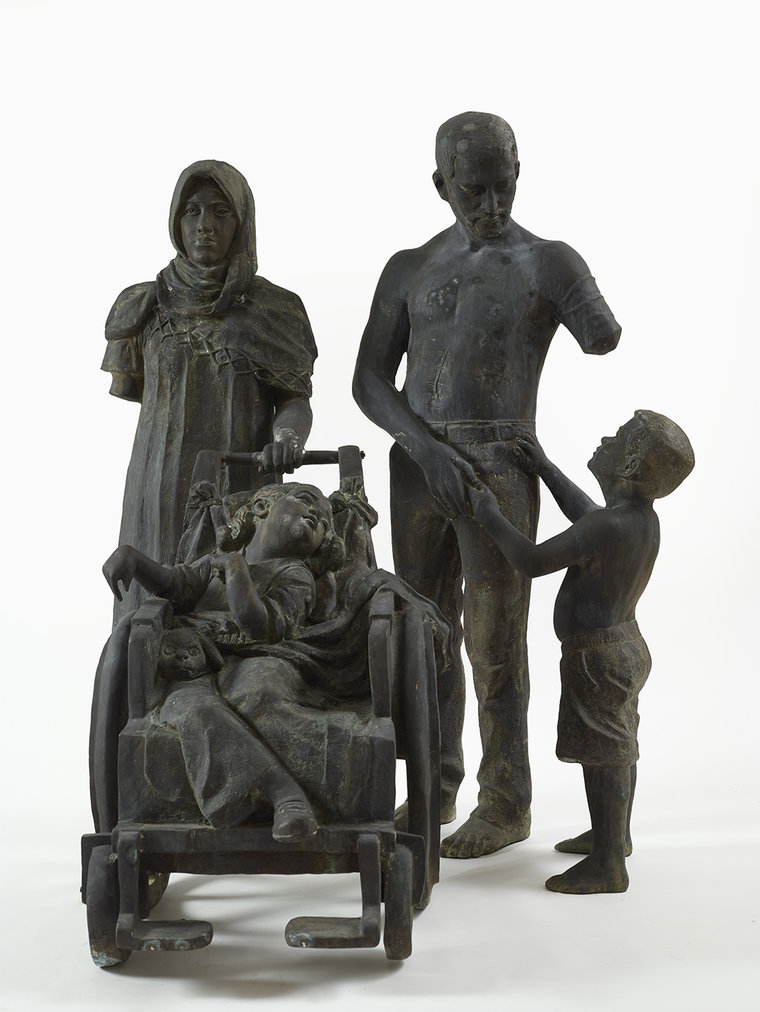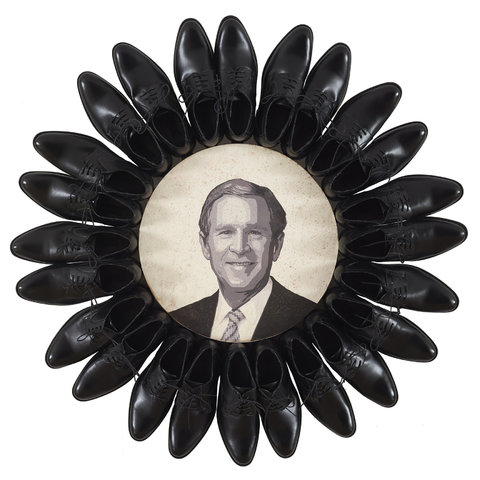Mahmoud Obaidi’s Operation Iraqi Freedom Family, 2016, is a life-size bronze sculpture that merges traditional sculptural techniques with materials charged by contemporary political history. The work was cast from a mixture of bronze and fragments of recycled American military equipment, specifically weapons and Humvees left behind in Iraq after the 2003 U.S.-led invasion and subsequent occupation of the country, known as Operation Iraqi Freedom. This choice of medium is central to the meaning of the piece: the materials themselves bear the physical residue of war, violence, and occupation, and Obaidi transforms them into a sculptural testimony of loss and survival.
The sculpture depicts a family of four: a veiled mother with an amputated right arm stands solemnly as her left hand grips the back of a wheelchair that seats her disabled young daughter, while the father, with an amputated left arm, turns his attention to his reaching son while gently holding his hand. Arranged in a close cluster, the figures recall familiar family portraits, yet their physical conditions immediately foreground the devastating human cost of the war. The work presents a displaced and severely wounded family, while emphasizing the soft tenderness between the members through their care for each other reflected in their subtle physical connection with one another, as if to insist on their humanness in conditions that strip them of their humanity. By fragmenting the family unit in this way, Obaidi underscores that war’s toll is not abstract: it is inscribed onto bodies and generations.
Obaidi has directly tied this work to the U.S. military’s invasion of Iraq, which left millions of Iraqis displaced, 3 million orphans, 4.5 million disabled, and countless children born with deformities. By naming the sculpture after the military campaign, he subverts the rhetoric of “freedom,” exposing instead its devastating aftermath. The work becomes a counter-monument, rejecting heroic commemoration and bearing witness to collective injury.
The medium of Operation Iraqi Freedom Family is central to its message. Bronze, traditionally associated with permanence in public monuments, is here alloyed with the remnants of war machinery. The surface is austere, rough, and unfinished, retaining the harshness of its cast and resisting any idealized patina. By transforming the material once used to manufacture weapons into sculptural human forms, Obaidi creates a record of war, loss, and survival.
Sketches from 2015 show Obaidi’s careful planning of scale and arrangement. The life-size forms of the three family members were conceived to confront the viewer directly. The wheelchair-bound child is positioned in the foreground, closest to the spectator, collapsing the gap between audience and subject and forcing immediate recognition of war’s physical toll.
The work serves as both memorial and accusation of war crimes. It honors lives permanently scarred and destroyed by warfare while holding accountable those responsible. As Obaidi explained: “When I think of the family, the Operation Iraqi Freedom Family, I have to do it as a sculpture, and have to use these materials. It says this is what you did to us.” His words emphasize that the sculpture is not passive remembrance but an assertive indictment. By embedding the very remnants of weapons into bronze, Obaidi ensures that Iraq’s experience of invasion remains visibly and materially present.
signed 'Obaidi 2015' lower back of wheelchair







